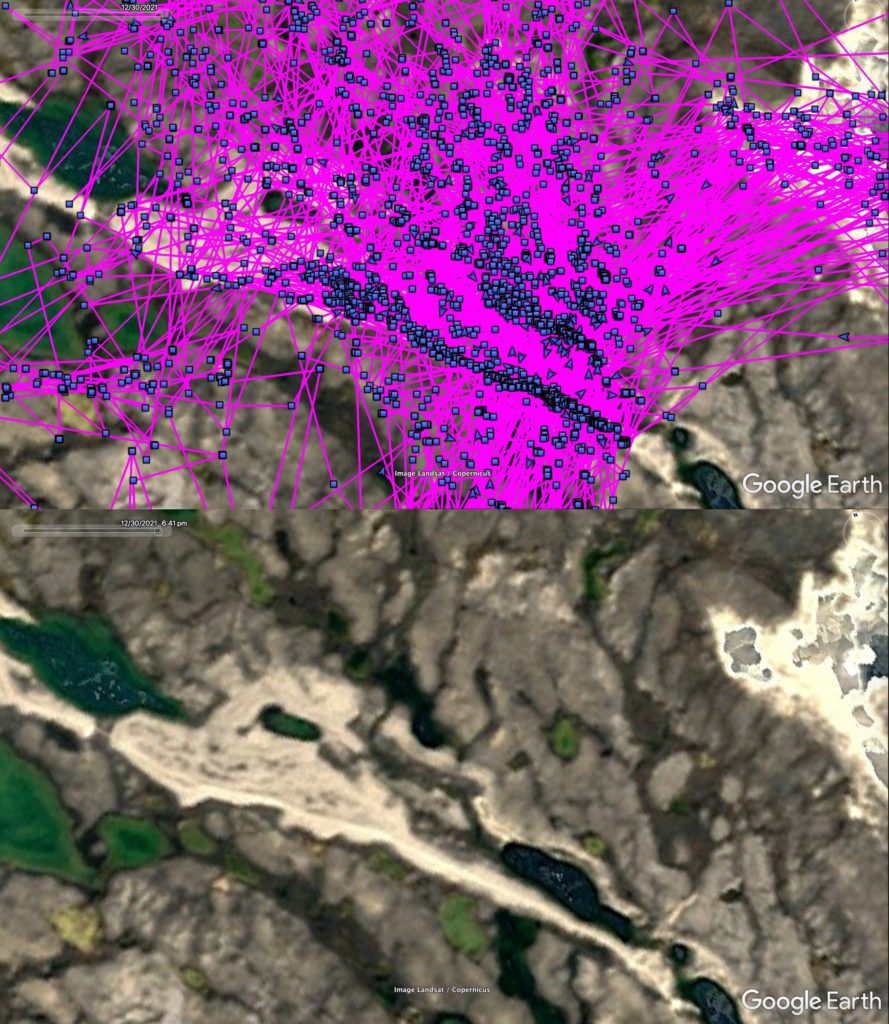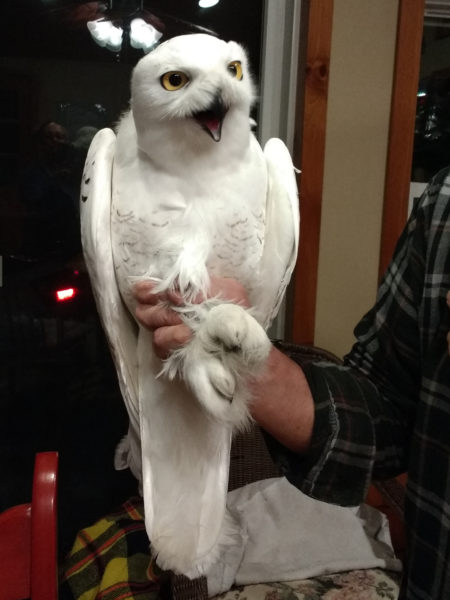
Hochelaga’s movements from April to December 2021, including 800 km (500 miles) across Hudson Bay. (©Project SNOWstorm and Google Earth)
It’s always exciting when a previously tagged owl returns south, carrying with it months’ — or even years’ — worth of backlogged data. We got two such returns in the past week or so, including a snowy owl we’ve been especially hoping to hear from.

Falcon Environmental biologist Julie Lecours with Hochelaga after the old male was caught at the Montréal airport last winter. (©Julie Lecours)
Hochelaga: The day after Christmas we were pleased to see Hochelaga check in for the first time this winter. This old, fully adult male was trapped last winter at the Montréal airport (where he’d first been banded in 2016), tagged and moved well to the west into southern Ontario — from which he quickly returned, spending the rest of the winter back at the airport.
Hochelaga’s newly uploaded data shows that he migrated north in late March 2021, lingering for a week or two at a time along western James Bay before making a two-and-a-half-day crossing of Hudson Bay in late April, flying more than 800 km (500 miles) from Cape Henrietta Maria to Coats Island far to the north. This was not an open-water crossing; that part of Hudson Bay is still generally frozen through early July.
Just beyond Coats lies Southampton Island, and that’s where Hochelaga spent last summer — and, judging from his data, where he was likely defending and provisioning a nest. It’s a little harder to judge nesting behavior with a male than a female, since the latter spend weeks at a stretch incubating eggs and thus create hundreds of GPS points in exactly the same place. A territorial male covers a wider range, especially when he starts hunting for the growing chicks, and he’ll spend more time on favorite perches near the nest than at the nest site itself. Also, the chicks leave the nest bowl well before the time they can fly, scattering and hiding on the tundra for safety from predators, at which point the male’s movements become even less centralized.

Hochelaga often used the high ground along both sides of a string of small tundra lakes as sentinel and hunting perches, as shown by the satellite photos with and without tracking data. (©Project SNOWstorm and Google Earth)
But it’s clear Hochelaga was watching a nest area on what appears to be a rise above a series of small tundra lakes, while he used a number of perches just across the valley a few hundred meters away, creating a very linear pattern of GPS locations. He remained in an area of about 20 sq. km (about 7.5 sq. miles) from mid-May until the beginning of October.
He took his time deciding to leave the Arctic. He didn’t depart Southampton Island until Nov. 20, crossing 200 km (125 miles) of then-ice free water via Nottingham Island to the northern Ungava Peninsula, and Dec. 15 he was still just east of the Inuit community of Inukjuak. Then he switched to high gear, moving more than 1,500 km (940 miles) in just eight days, homing his way back to — you guessed it — the Montréal airport.
Well, almost. Hochelaga actually stopped just shy of the airport, and has been hanging around Autoroute 40, the busiest highway in Québec within sight of the departing jets, as well as some less dangerous locations in Montréal and its neighboring communities to the north. Let’s hope he stays safe.

Otter’s movements from April-November, 2020. (©Project SNOWstorm and Google Earth)
Otter: Otter was a second-winter male, caught on Cape Vincent in upstate New York, when Tom McDonald fitted him with the first hybrid (GSM cellular and Argos satellite) transmitter we ever deployed in January 2019. After wintering that year near Fort Drum, NY, Otter migrated north to Baffin Island, coming south in December 2019 and spending the winter near Montréal.

Otter, after his capture in January 2019. (©Tom McDonald)
But after he headed north in April 2020, he stayed north. Thanks to weekly satellite fixes we knew where he was during the summer in both 2020 and 2021 (southern Baffin Island the first year, and the Melville Peninsula in the central Canadian Arctic the next), but his winter movements from October through February were a mystery because of a hiccup in his Argos duty cycle, which shut down the satellite part of the unit during that period each year. We had a new duty cycle cued up and ready go — but Otter needed to come back south into cell range to pick it up. (We can’t send software commands through the satellite network.)
Last winter, though, he never showed up. Come March, when his weekly Argos fixes started up again, we realized he’d wintered on the Torngat Peninsula of northern Labrador, but all the rich detail of his wanderings since March 2020 were still locked in his transmitter’s memory banks.
However, last evening, Dec. 30, we got the message we’d been hoping for — Otter was back in cell range, and had uploaded almost 9,600 GPS points. That covers less than half of his time since his last connection, taking us through November 2020 up on the Torngat, but it’s a start, and we hope for more soon as his battery voltage allows. Interestingly, he connected near Palmarolle, QC, close to the Ontario border and roughly halfway between James Bay and Georgian Bay on Lake Huron, well west of his previous winter locations.
We haven’t dug too deeply into Otter’s data yet, though it appears he did not nest in 2020 on Baffin Island. (We have been assuming, based on the very sparse satellite data we got last summer, that he did nest in 2021. Once the rest of his highly detailed GSM data uploads we should be able to say with certainty.) Once his transmitter offloads the rest of its backlogged data, it should also then take up the corrected Argos duty cycle — and Otter shouldn’t ever go off the grid again, we hope.


9 Comments on “Hochelaga and Otter Return”
That is great to hear. Although I live in Wi. it is cool to hear about other places of migration of the Snowy Owls.
What wonderful stories of strength and survivial. Such a great message at the end of the year. Thank you and thanks to the gorgeous Snowy Owls who bring me hope with each message you send.
Fascinating work. My thanks to all who contribute. Paul N.
Snowy Owls are really amazing birds. And thanks to the latest technology and dedicated researchers we are learning more about them all the time!
Snowy owls have been coming more to Chatham-Kent and Lambton County in Southern Ontario Canada, some photographers have taken as many as 15- 19 snowy owls pictures. I don’t know if any are banded. I am new to photography and have had the pleasure of photographing 3 different great beauties from a distance this December. There are many new windmills unfortunately and 5 -6 owls have been taken to the rehabilitation center, but made recovery!! Many farmers have been removing habitate in the area and I fear this may result in wildlife declines. My hope is they stop. Keep our forests!
Any news on the snowy in the DC area that I read about this week?
Debbi Z
According to eBird it was seen as recently as Jan. 10.
Hi Scott
Will you be doing any more of the spaghetti type images. Like how this year’s class came South?
I actually tried to generate a multi-owl track map earlier this season, but my Google Earth Pro (which is the program we use for displaying the raw data, and which at this point has a couple gazillion snowy owl points saved as My Places on my laptop) seems to be balking at displaying them properly. I meant to go back and try to find a workaround, and this is a nudge for me to try. Thanks.